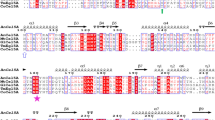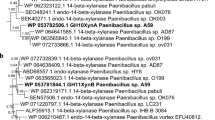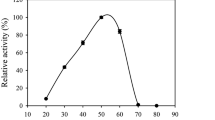Abstract
In a halotolerant fungus Aspergillus glaucus CCHA, several functional proteins with stress-tolerant activity have been studied, but no secretory enzymes have been identified yet. The unique GH5 cellulase candidate from A. glaucus, an endoglucanase termed as AgCMCase, was cloned, expressed in the Pichia pastoris system and the purified enzyme was characterized. A large amount of recombinant enzyme secreted by the P. pastoris GS115 strain was purified to homogeneity. The molecular weight of the purified endoglucanase is about 55.0 kDa. The AgCMCase exhibited optimum catalytic activity at pH 5.0 and 55 °C. However, it remained relatively stable at temperatures ranging from 45 to 80 °C and pH ranging from 4.0 to 9.0. In addition, it showed higher activity at extreme NaCl concentrations from 1.0 to 4.0 M, suggesting it is an enzyme highly stable under heat, acid, alkaline and saline conditions. To evaluate the catalytic activity of AgCMCase, the hydrolysis products of rice and corn straws were successfully studied. In conclusion, the AgCMCase is a thermostable and salt-tolerant cellulase with potential for industrial application.






Similar content being viewed by others
Abbreviations
- NCBI:
-
The National Center for Biotechnology Information
- CAZY:
-
Carbohydrate-active enzymes
- CMCase:
-
Carboxymethyl cellulase
- SDS-PAGE:
-
Sodium dodecyl sulfate polyacrylamide gel electrophoresis
- IPTG:
-
Isopropyl-β-d-thiogalactopyranoside
- CMC-Na:
-
Sodium carboxymethyl cellulose
- MES:
-
2-(N-morpholino)ethanesulfonic acid
- HEPES:
-
4-(2-Hydroxyethyl)-1-piperazineethanesulfonic acid
- EDTA:
-
Ethylenediaminetetraacetic acid
- K m :
-
Michaelis–Menten constant
References
Altschul SF, Madden TL, Schäffer AA, Zhang J, Zhang Z, Miller W, Lipman DJ (1997) Gapped BLAST and PSI-BLAST: a new generation of protein database search programs. Nucleic Acids Res 25:3389–3402
An T, Dong Z, Lv J, Liu Y, Wang M, Wei S, Song Y, Zhang Y, Deng S (2015) Purification and characterization of a salt-tolerant cellulase from the mangrove oyster, Crassostrea rivularis. Acta Biochim Biophys Sin (Shanghai) 47:299–305
Aygan A, Karcioglu L, Arikan B (2013) Alkaline thermostable and halophilic endoglucanase from Bacillus licheniformis C108. Afr J Biotechnol 10:789–796
Beguin P, Aubert JP (1994) The biological degradation of cellulose. FEMS Microbiol Rev 13:25–58
Bhat S, Hutson R, Owen E, Bhat M (1997) Determination of immunological homology between cellulosome subunits and cloned endoglucanases and xylanase of Clostridium thermocellum. Anaerobe 3:347–352
Bianchetti CM, Brumm P, Smith RW, Dyer K, Hura GL, Rutkoski TJ, Phillips GN (2013) Structure, dynamics, and specificity of endoglucanase D from Clostridium cellulovorans. J Mol Biol 425:4267–4285
Cavaco-Paulo A (1998) Mechanism of cellulase action in textile processes. Carbohydr Polym 37:273–277
Cheng J, Huang S, Jiang H, Zhang Y, Li L, Wang J, Fan C (2016) Isolation and characterization of a non-specific endoglucanase from a metagenomic library of goat rumen. World J Microbiol Biotechnol 32:1–8
Cho KM, Hong SJ, Math RK, Islam SM, Kim JO, Lee YH, Kim H, Yun HD (2008) Cloning of two cellulase genes from endophytic Paenibacillus polymyxa GS01 and comparison with cel 44C-man 26A. J Basic Microbiol 48:464–472
Dammak DF, Smaoui SM, Ghanmi F, Boujelben I, Maalej S (2016) Characterization of halo-alkaline and thermostable protease from Halorubrum ezzemoulense strain ETR14 isolated from Sfax solar saltern in Tunisia. J Basic Microbiol 56(4):337–346
Daoud L, Jlidi M, Hmani H, Hadj Brahim A, El Arbi M, Ben Ali M (2017) Characterization of thermo-solvent stable protease from Halobacillus sp. CJ4 isolated from Chott Eldjerid hypersaline lake in Tunisia. J Basic 57(2):104–113
Dhar H, Kasana RC, Dutt S, Gulati A (2015) Cloning and expression of low temperature active endoglucanase EG5C from Paenibacillus sp. IHB B 3084. Int J Biol Macromol 81:259–266
Goodarzi H, Torabi N, Najafabadi HS, Archetti M (2008) Amino acid and codon usage profiles: adaptive changes in the frequency of amino acids and codons. Gene 407:30–41
Henrissat B, Driguez H, Viet C, Schulein M (1985) Synergism of cellulases from Trichoderma reesei in the degradation of cellulose. Nat Biotechnol 3:722–726
Jaouani A, Neifar M, Prigione V, Ayari A, Sbissi I, Ben Amor S, Ben Tekaya S, Varese GC, Cherif A, Gtari M (2014) Diversity and enzymatic profiling of halotolerant micromycetes from Sebkha El Melah, a Saharan salt flat in Southern Tunisia. Biomed Res Int 2014:439197
Kim SC, Kang SH, Choi EY, Hong YH, Bok JD, Kim JY, Lee SS, Choi YJ, Choi IS, Cho KK (2016) Cloning and characterization of an endoglucanase gene from Actinomyces sp. Korean native goat 40. Asian Australas J Anim Sci 29:126–133
Klinke HB, Thomsen AB, Ahring BK (2004) Inhibition of ethanol-producing yeast and bacteria by degradation products produced during pre-treatment of biomass. Appl Microbiol Biotechnol 66:10–26
Ko CH, Tsai CH, Lin PH, Chang KC, Tu J, Wang YN, Yang CY (2010) Characterization and pulp refining activity of a Paenibacillus campinasensis cellulase expressed in Escherichia coli. Bioresour Technol 101:7882–7888
Kuhad RC, Gupta R, Singh A (2011) Microbial cellulases and their industrial applications. Enzyme Res 10:1–10
Larkin MA, Blackshields G, Brown NP, Chenna R, McGettigan PA, McWilliam H, Valentin F, Wallace IM, Wilm A, Lopez R, Thompson JD, Gibson TJ, Higgins DG (2007) Clustal W and Clustal X version 2.0. Bioinformatics 23:2947–2948
Lee YJ, Kim BK, Lee BH, Jo KI, Lee NK, Chung CH, Lee YC, Lee JW (2008) Purification and characterization of cellulase produced by Bacillus amyoliquefaciens DL-3 utilizing rice hull. Bioresour Technol 99:378–386
Letunic I, Doerks T, Bork P (2015) SMART: recent updates, new developments and status in 2015. Nucleic Acids Res 43:D257–D260
Li X, Yu HY (2012) Characterization of an organic solvent-tolerant α-amylase from a halophilic isolate, Thalassobacillus sp. LY18. Folia Microbiol (Praha) 57(5):447–453
Li X, Yu HY (2013) Characterization of a halostable endoglucanase with organic solvent-tolerant property from Haloarcula sp. G10. Int J Biol Macromol 62:101–106
Liang Y, Feng Z, Yesuf J, Blackburn JW (2010) Optimization of growth medium and enzyme assay conditions for crude cellulases produced by a novel thermophilic and cellulolytic bacterium, Anoxybacillus sp. 527. Appl Biochem Biotechnol 160:1841–1852
Liang C, Fioroni M, Rodríguez-Ropero F, Xue Y, Schwaneberg U, Ma Y (2011) Directed evolution of a thermophilic endoglucanase (Cel5A) into highly active Cel5A variants with an expanded temperature profile. J Biotechnol 154:46–53
Liang X, Liu Y, Xie L, Liu X, Wei Y, Zhou X, Zhang S (2015) A ribosomal protein AgRPS3aE from halophilic Aspergillus glaucus confers salt tolerance in heterologous organisms. Int J Mol Sci 16:3058–3070
Lineweaver H, Burk D (1934) The determination of enzyme dissociation constants. J Am Chem Soc 56:658–666
Liu XD, Liu JL, Wei Y, Tian YP, Fan FF, Pan HY, Zhang SH (2011) Isolation, identification and biologic characteristics of an extreme halotolerant Aspergillus sp. J Jilin Univ 49:548–552
Liu G, Qin Y, Hu Y, Gao M, Peng S, Qu Y (2013) An endo-1,4-b-glucanase PdCel5C from cellulolytic fungus Penicillium decumbens with distinctive domain composition and hydrolysis product profile. Enzyme Microb Technol 52:190–195
Liu XD, Xie L, Wei Y, Zhou X, Jia B, Liu J, Zhang S (2014) Abiotic stress resistance, a novel moonlighting function of ribosomal protein RPL44 in the halophilic fungus Aspergillus glaucus. Appl Environ Microbiol 80:4294–4300
Liu XD, Wei Y, Zhou XY, Pei X, Zhang SH (2015) Aspergillus glaucus aquaglyceroporin gene glpF confers high osmosis tolerance in heterologous organisms. Appl Environ Microbiol 81:6926–6937
Lynd LR, Weimer PJ, van Zyl WH, Pretorius IS (2002) Microbial cellulose utilization: fundamentals and biotechnology. Microbiol Mol Biol Rev 66:506–577
Miller GL (1959) Use of dinitrosalicylic acid reagent for determination of reducing sugar. Anal Chem 31(3):426–428
Oren A (2010) Industrial and environmental applications of halophilic microorganisms. Environ Technol 31(8–9):825–834
Park IH, Chang J, Lee YS, Fang SJ, Choi YL (2012) Gene cloning of endoglucanase Cel5A from cellulose-degrading Paenibacillus xylanilyticus KJ-03 and purification and characterization of the recombinant enzyme. Protein J 31:238–245
Paul S, Bag SK, Das S, Harvill ET, Dutta C (2008) Molecular signature of hypersaline adaptation: insights from genome and proteome composition of halophilic prokaryotes. Genome Biol 9:R70
Pei X, Zhao J, Cai P, Sun W, Ren J, Wu Q, Zhang S, Tian C (2015) Heterologous expression of a GH3 beta-glucosidase from Neurospora crassa in Pichia pastoris with high purity and its application in the hydrolysis of soybean isoflavone glycosides. Protein Expr Purif 119:75–84
Poonam SN (2013) Microbial enzymes with special characteristics for biotechnological applications. Biomolecules 3(3):597–611
Roy A, Kucukural A, Zhang Y (2010) I-TASSER: a unified platform for automated protein structure and function prediction. Nat Protoc 5:725–738
Salvachúa D, Prieto A, López-Abelairas M, Lu-Chau T, Martínez AT, Martínez MJ (2011) Fungal pretreatment: an alternative in second-generation ethanol from wheat straw. Bioresour Technol 102:7500–7506
Schramm LL, Stasiuk EN, Marangoni DG (2003) Surfactants and their applications. Annu Rep Prog Chem Sect C Phys Chem 99:3–48
Sun Y, Cheng J (2002) Hydrolysis of lignocellulosic materials for ethanol production: a review. Bioresour Technol 83:1–11
Teeri TT (1997) Crystalline cellulose degradation: new insight into the function of cellobiohydrolases. Trends Biotechnol 15:160–167
Varrot A, Schulein M, Davies GJ (2000) Insights into ligand-induced conformational change in Cel5A from Bacillus agaradhaerens revealed by a catalytically active crystal form. J Mol Biol 297:819–828
Wang Y, Yuan H, Wang J, Yu Z (2009) Truncation of the cellulose binding domain improved thermal stability of endo-beta-1,4-glucanase from Bacillus subtilis JA18. Bioresour Technol 100:345–349
Wang J, Gao G, Li Y, Yang L, Liang Y, Jin H, Han W, Feng Y, Zhang Z (2015) Cloning, expression, and characterization of a thermophilic endoglucanase, AcCel12B from Acidothermus cellulolyticus 11B. Int J Mol Sci 16:25080–25095
Wood TM, McCRAE SI, Bhat KM (1989) The mechanism of fungal cellulase action. Synergism between enzyme components of Penicillium pinophilum cellulase in solubilizing hydrogen bond-ordered cellulose. Biochem J 260:37–43
Yin YR, Zhang F, Hu QW, Xian WD, Hozzein WN, Zhou EM, Ming H, Nie GX, Li WJ (2015) Heterologous expression and characterization of a novel halotolerant, thermostable, and alkali-stable GH6 endoglucanase from Thermobifida halotolerans. Biotechnol Lett 37(4):857–862
Zarafeta D, Kissas D, Sayer C, Gudbergsdottir SR, Ladoukakis E, Isupov MN, Chatziioannou A, Peng X, Littlechild JA, Skretas G, Kolisis FN (2016) Discovery and characterization of a thermostable and highly halotolerant GH5 cellulase from an Icelandic hot spring isolate. PLoS ONE 11:e0146454
Zhang SH (2016) The genetic basis of abiotic stress resistance in extremophilic fungi: the genes cloning and application. In: Fungal applications in sustainable environmental biotechnology. Springer, New York, pp 29–42
Acknowledgements
This work was supported by the National Natural Science Foundation of China (NSFC: 31171794, 31370689, 31670141, and 31671972).
Author information
Authors and Affiliations
Corresponding authors
Additional information
Communicated by A. Driessen.
Electronic supplementary material
Below is the link to the electronic supplementary material.
Rights and permissions
About this article
Cite this article
Li, Z., Pei, X., Zhang, Z. et al. The unique GH5 cellulase member in the extreme halotolerant fungus Aspergillus glaucus CCHA is an endoglucanase with multiple tolerance to salt, alkali and heat: prospects for straw degradation applications. Extremophiles 22, 675–685 (2018). https://doi.org/10.1007/s00792-018-1028-5
Received:
Accepted:
Published:
Issue Date:
DOI: https://doi.org/10.1007/s00792-018-1028-5




